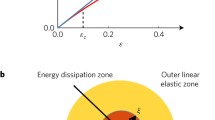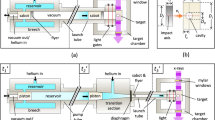Abstract
Fracture initiation due to a hydrostatic tensile stress field is studied by considering an idealized solid containing a small spherical cavity. Finite elastic deformation theory assuming Neo-Hookean material behavior is combined with an energy criterion to determine the critical cavity and applied stress at instability. It is found that the critical stress is a monotonically increasing function of a parameter, k = 6T/Eao, that is proportional to specific surface energy and inversely proportional to initial cavity size and modulus. For large cavities, the critical applied stress has the familiar Griffith form pc (k → 0) + (/43) (ET/ao)1/2, while for small cavities the critical stress tends to a constant pc (k →) = 2T/ao. Some final comments pertain to the relation between applied stress and local stress and strain at the point of fracture.
Résumé
On étudie la provocation d'une fracture dûe à un champs de contraintes de tension hydrostatique, en considérant un solide idéal contenant une petite cavité sphérique. La theorie des déformations elastiques finies supposant un comportement des lois Néo-Hookéennes du matériaux est combinée avec un critère d' énergie pour déterminer la cavité critique et la contrainte appliquée d la stabilité. On trouve que la contrainte critique est une fonction croissante et monotone du parametre k = 6T/Eao, c'est à dire proportionnelle à une energie spécifique de surface et inversement proportionnelle à la taille initiale de la cavité et du module. Pour de larges cavités, la contrainte critique appliquée, a la forme bien connue de Griffith pc (k → 0) = (\43) (ETao)1/2, tandis que pour les petites cavités, la contrainte critique tend vers une contrante pc (k → ∞) = 2T/ao, Quelques commentaires finaux traitente de la relation entre la contrainte appliquée, la contrainte locale et la tension au point de fracture.
Zusammenfassung
Die Brucheinleitungi nfolge eines hydrostatischen Spannungsfeides wind in einem idealisierten Material, das einen kleinen kugelfoermigen Hohlraum enthaelt, untersucht. Unter den Annahme eines Neo-Hookschen Materialverhaltens wind die elastische Theorie kleiner Verformungen angewendet and mit einem Energiekriterium zusammen die kritische Groesse des Hohlraumes Bowie die kritische Spannung fuer Instabilitaet bestimmt. Wie sich herausstellt ist die kritische Spannung eine monoton ansteigende Funktion des Parameters k = 6TEao, das heisst sie ist proportional zur spezifischen Oberflaechenenergie and umgekehrt proportional zur Anfangsgroesse des Hohlraumes and zum Eiastizitaetsmodul. Fuer einen grossen Hohlraum hat die kritische Spannung die bekannte Griffith-Form pc (k → 0) =(4/3) (ET/ao)1/2, waehrend die kritische Spannung fuer einen kleinen Hohlraum einer Konstanten pc (k → ∞ = 2T/ao zustrebt. Einige abschliessende Bemerkungen betreffen die Beziehung zwischen den angewendeten Spannung and der oertlichen Spannung and Dehnung am Bruchpunkt.
Similar content being viewed by others
References
Griffith, A.A.: The Phenomena of Rupture and Flow in Solids. Philosophical Transactions of the Royal Society (London), Series A, Vol. 221, 1921.
Williams, M.L.: The Structural Analysis of Viscoelastic Materials. American Institute of Aeronauties and Astronauties Journal, Vol. 2, 1964, p. 785.
Gent, A. N.; Lindley, P.B.: Internal Rupture of Bonded Rubber Cylinders in Tension. Proceedings of the Royal Society A. Vol. 249, 1959, p. 195.
Green,A.E.; Zerna, W. Theoretical Elasticity, University Press, Oxford.
Nadai, A.: Theory of Flow and Fracture of Solids. Publ. , McGraw-Hill Book Company, Inc. 1950, p.175.
Author information
Authors and Affiliations
Rights and permissions
About this article
Cite this article
Williams, M.L., Schapery, R.A. Spherical flaw instability in hydrostatic tension. Int J Fract 1, 64–72 (1965). https://doi.org/10.1007/BF00184154
Received:
Issue Date:
DOI: https://doi.org/10.1007/BF00184154




